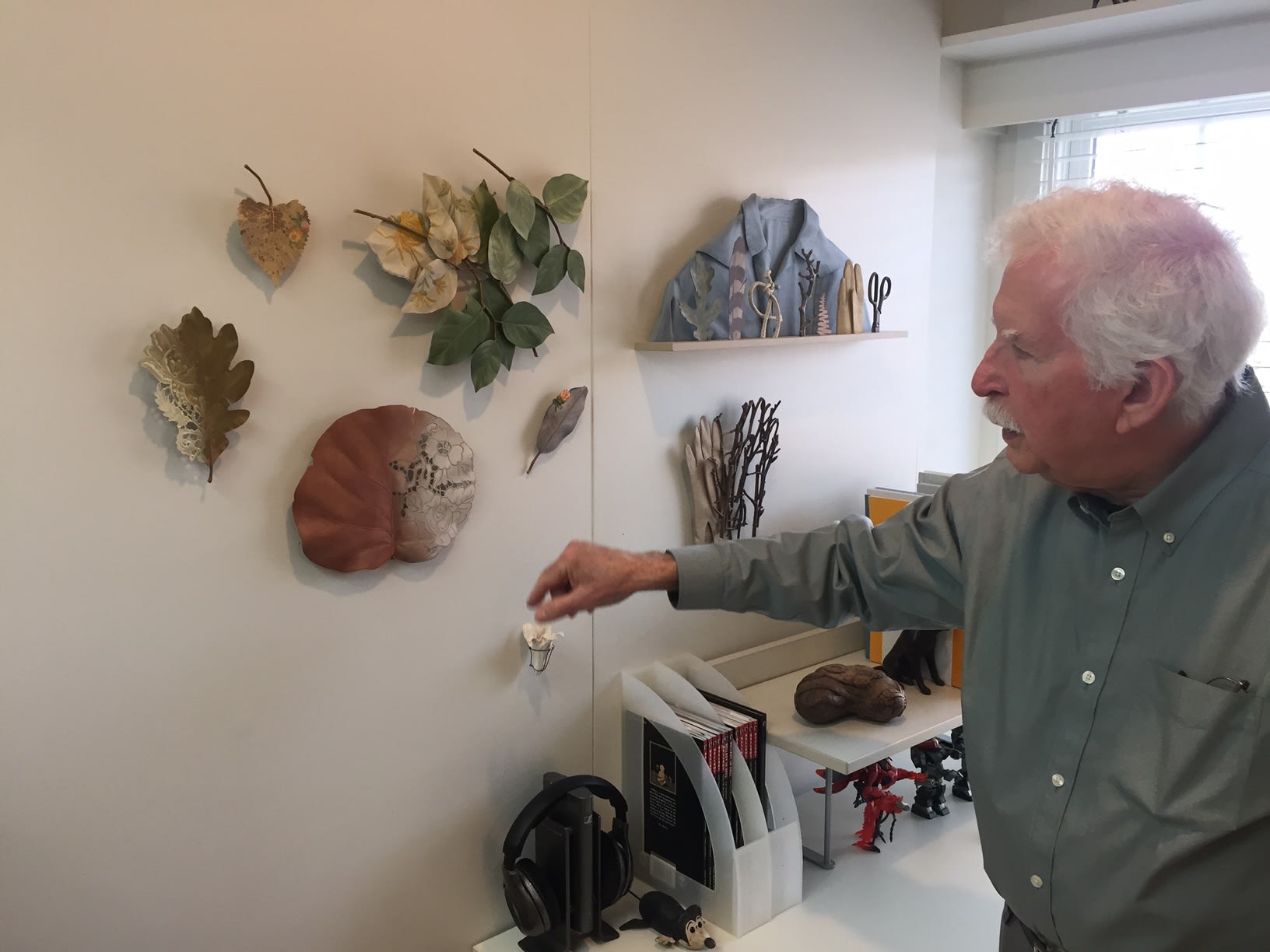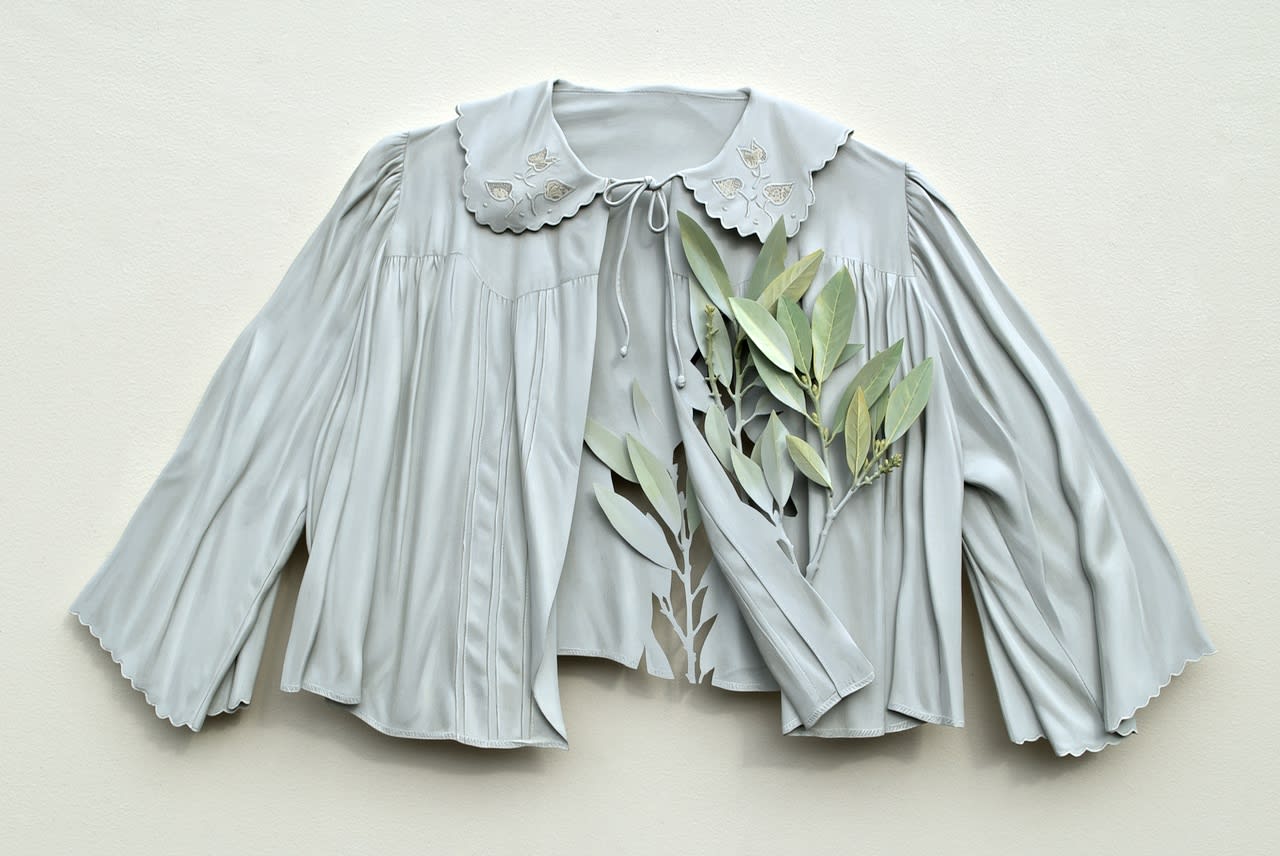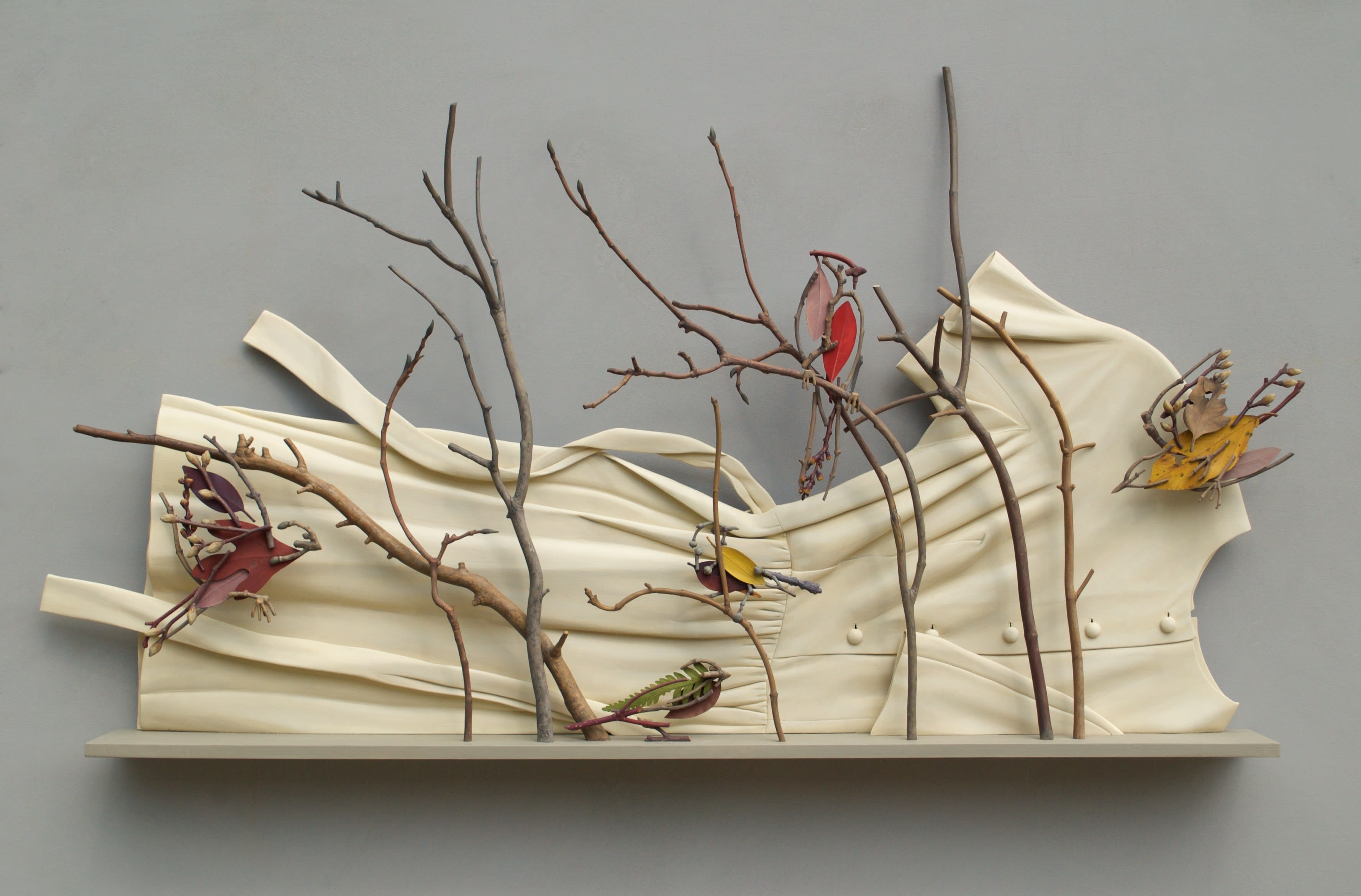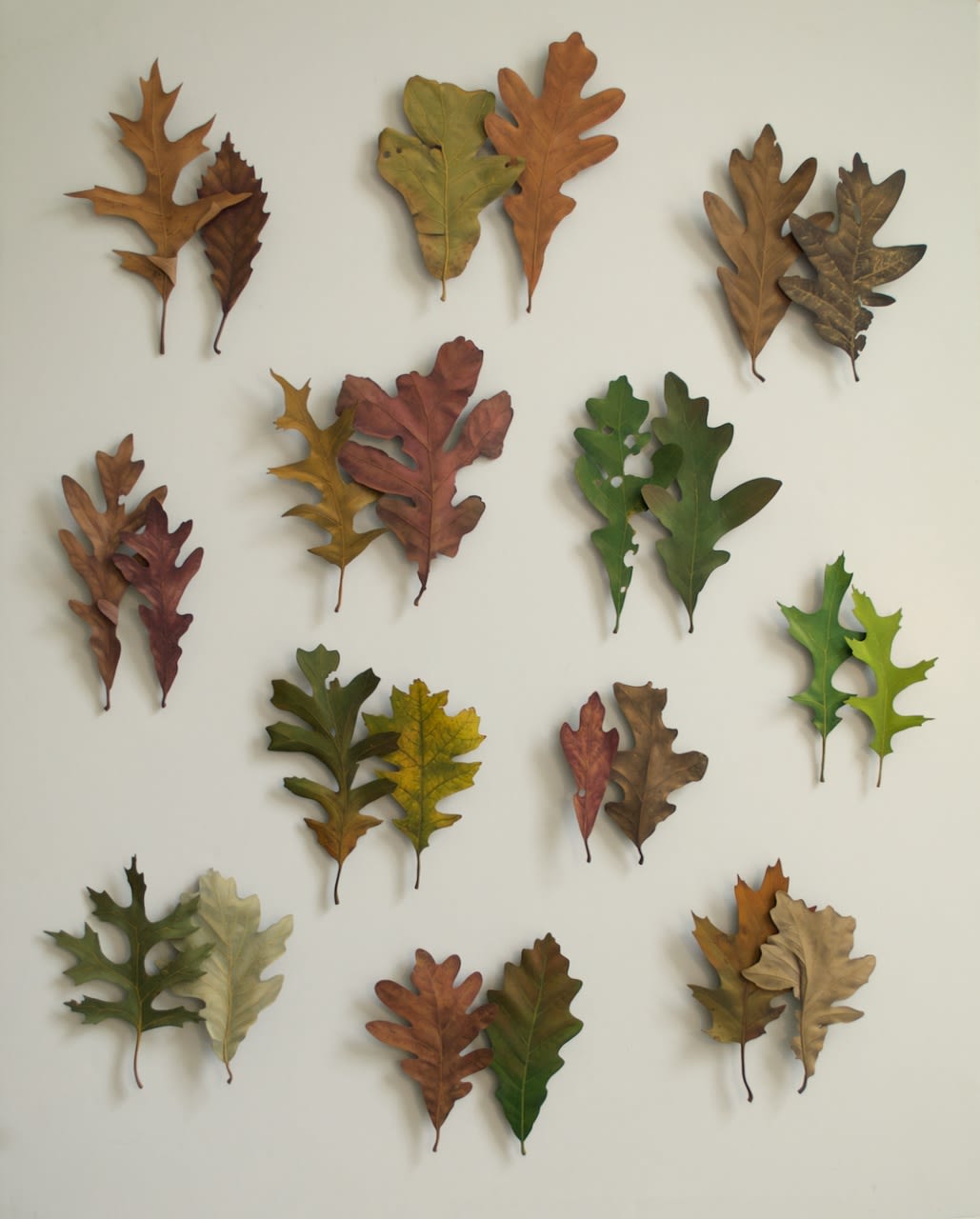An interview with Ron Isaacs

AF: Can you tell me about the trajectory of your art career?
RI: My parents were from eastern Kentucky, very rural, and they moved to Cincinnati before I was born. I was born in Cincinnati in 1941 and started drawing fairly early. And for some reason, we’ve never figured out why, when anyone asked me what I wanted to be when I grew up I never said anything but an artist. I don’t know where it came from or why. But at any rate I never questioned it. Didn’t even go through the cowboy stage or the fireman stage or anything.
My parents moved back to Kentucky when I was 12. I had no opportunity to take art in high school at all. What I did was self-taught until I got to college. I went to Berea College in Kentucky and majored in art there and then went on to grad school at Indiana University and majored in painting. So I was trained as a painter.
About 1970, while I was working on canvas as a normal painter would, I happened to get the idea of attaching a piece of sawed out plywood to the surface of the canvas with an image on it to add another level and a little bit more interest. After I did about three of those, painting images on the surface of the cutout wood, I said why do I need the canvas? I can make any shape I want! So that was my big epiphany and eureka moment and I started sawing out everything and layering them first.
I was doing figurative imagery at the time, based on magazines, newspaper, photographs and other sources. I was stacking things, lots of multiple images. And eventually that led to an improvement in craftsmanship and learning to construct things out of many pieces of wood, trying to make relief sculpture. These were then painted and the trompe l’oeil things came along, you know ‘fool the eye’. Garments were my first subject matter for that, filled often with figurative imagery pouring out of them or other things.
AF: And when was that?
RI: This was the early 70s, about 1972. I think the first piece was my own raincoat. It took me forever to try to build it out of 3/8 inch regular domestic plywood, which is pretty raw stuff. Lots of cheap filler and so on. Eventually I discovered Finnish birch plywood, which is much higher quality with no fillers and many layers. That was a big step up in improvement. That’s what became my career, basically, are these relief constructions. I now define them as being almost exactly halfway between painting and sculpture. I used to have a sculpture friend who would kid me that someday I was going to invent sculpture all by myself.
I sort of did because I stumbled in through the back door, I think. It’s still hard for me to think of myself as a woodworker or as a wood craftsman at all because I’m still making surfaces to hang paint on. I sometimes have to define myself as a sculpture or a painter. The works came out of painting but they really are exactly halfway between. That breaks down into the division of labor too, because it usually takes about half the work to construct and half the work to paint. Some are harder to build, some are harder to paint. The idea is to translate flat panels or sections of birch plywood of various thicknesses into something that flows, behaves, like fabric or leaves. That’s just my way of working that evolved out of the original imagery.

Ron Isaacs, TROUSSEAU, Trompe l'oeil. Acrylic on birch plywood, 19-1/2 x 33 x 2-3/4 inches
AF: How do you construct the pieces?
RI: A lot of Elmer’s carpenter’s glue...it’s very high tech [laughs]. Basically the garment or leaves, or whatever object it is, is pinned up to a Styrofoam board gridded off into one inch squares. It’s always a 1:1 relationship, I’m always looking at something. Then on paper gridded off in one inch squares I make a contour line pattern, just an accurate drawing of where all the edges are and the shapes involved and then I start making tracing paper patterns based on that and looking at the garment or object, trying to analyze it in terms of planes that I can saw out and join together to make a surface. A large piece may take hundreds of pieces of wood, a dress for instance.
If you get enough pieces of wood going you can build about any surface. They’re layered various ways. They aren’t carved, there are no knives or chisels involved, but there is a lot of sanding, which is a form of carving, I realize. But I’ve never learned to carve. And you don’t carve plywood easily anyhow. My strategy is to build as much of the surface as I can without making myself crazy and then to rely on the paint to carry the rest of the illusion.
I very much enjoy the fusion and confusion of real and illusory form. So part of it is actual form, which is where I have a leg up on the old trompe l’oeil painters, and the illusion of form I get from color and value changes and details that are painted on that. I use acrylic paints, I couldn’t possibly deal with the drying time of oil. This means I’ve had to develop some drybrush techniques and other techniques to be able to blend smoothly because you can only do so much wet into wet. Actually I do very little wet into wet. This is not the way I was trained to paint, I was actually a fairly painterly painter using oils until 1967. I’m still painterly because I see painterly. You can’t see a lot of brushwork in my pieces, but I’m not afraid for you to catch me painting. I’m not trying to completely hide the presence of a painter.

Ron Isaacs, PASSERINES, Trompe l'oeil. Acrylic on birch plywood, 23 x 42-3/4 x 6 inches
AF: What is your favorite tool?
RI: That would be a scroll saw, which allows me to make whatever shape I want. The only tools I really use are a scroll saw and a belt disk sander and a Dremel that I use with a ½ inch sanding drum. Mostly the scroll saw and the belt disk sander. I use about a #3 blade on the scroll saw.
One of my main strategies is to set up something as being real and then violate it. I’ll find a way to interrupt it or create a metamorphosis or a transformation of some sort to make you go back and say wait a minute, how did I get here and question the reality of it.
I don’t consider myself a woodworker, truly, because I’ve never been into the romance of wood. Wood is sort of a friendly mystery, but basically I’m trying to make a surface to paint on. And the wood is all covered up. Before the pieces are painted they aren’t bad looking relief sculptures, actually.

Ron Isaacs, LITTLE SISTER, Trompe l'oeil. Acrylic on birch plywood, 32 x 22-3/4 x 3 inches
AF: Do they always hang on the wall?
RI: Yes. I guess I’ve done one or two pieces that didn’t have a back side but you can’t go all the way around. That would make me nuts completely to try to deal with an object in the round. One nice thing about garments is they stay close to the wall and present a surface that I can actually construct. I never made it all the way to 3 dimensions, I’m a 2.5 dimension artist.

Ron Isaacs, COUPLES, Acrylic on birch plywood construction, 8 x 8 x 1 inches
AF: You mentioned the first piece you did was your raincoat. Does that mean you always have a reference garment in front of you?
RI: Yes, that’s right, and I worked my way finally to trompe l’oeil because I like the authority that it gives the work. The authority of something seen directly that becomes convincing. I’m not actually fully committed to or terribly interested in the trompe l’oeil part of it. It’s just my way of making an image and the image is the important thing. It’s just to give the image authority. I think a lot of trompe l’oeil paintings…while I can be entertained by them, it isn’t terribly deep. It’s mainly a demonstration of skill, I think. You do get some surprising and remarkable and impressive images that way but I’m not that interested in just demonstrating technique. I’m trying to make a strong image.
I was trained as a formalist. When I was in grad school we didn’t talk about content much, we talked about the formal elements. We talked about composition and things like that, and that’s still the major element in the work to me, what it’s doing visually. I’m very concerned with shape and negative space, with color and form in general. If I can get an interesting—I don’t know if I like the word interesting or not because it has a reputation as being sort of a weak word, but sometimes it’s the best word—I’m trying for an interesting image, a strong combination of visual elements that presents itself in a striking way. After that I’m very lucky if I can make something with a good degree of psychological resonance as well. Something that’s evocative.
I think my job is to make an interesting object that’s as evocative as I can make it that draws responses from the viewer without being pretentious about it. I find that the more I talk about content the worse it gets in general, so I’m better off to present the work and let the viewer bring what they will to it, and get what they will from it. I know that’s sort of a cliché of contemporary art, you know the open content idea where I bring my life to the work and now you bring yours. It sounds terribly corny and pretentious. But you know, your experience in front of a work of art is yours. I try not to mess too much with it. I present something that could have a number of readings, and probably can’t predict what you will get from it.
AF: Thank you for talking with me today.
Momentum Gallery proudly represents Ron Isaacs' work. Stop by to see his marvelous painted constructions at the gallery in Asheville anytime and at CONTEXT Miami, December 4-9, 2018. Please contact us if you'd like to attend the contemporary Miami fair – we are happy to provide you complimentary passes.
